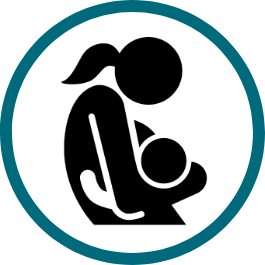Optimal breastfeeding of infants under two years of age has the potential to prevent over 800,000 deaths, 13% of all deaths in children under five in the developing world.1Breastfeeding in the 21st century: epidemiology, mechanisms, and lifelong effect
The Lancet, Volume 387, Issue 10017, 475 490
Victora, Cesar G et al. This is a home-based, daily behavior that needs to be practiced on demand, 8-12 times through the day and night.

Exclusive Breastfeeding
Mothers breastfeed exclusively for six months after birth
Key Points from Global Research
- A supportive family and a positive social environment are critical to initiating and continuing exclusive breastfeeding for the full 6 months.
- A woman's success with exclusive breastfeeding can be determined by her belief that she is capable of fulfilling her child's needs by breastfeeding only and her knowledge of or ability to get assistance with important breastfeeding skills to avoid problems.
Behavior Profile Sample: Exclusive Breastfeeding
A Behavior Profile is a summary analysis of each behavior. This sample draws from global evidence and illustrates the result of using the Create Behavior Profiles Tool to analyze factors, supporting actors and strategies and to ensure logical pathways exist between strategies proposed and factors related to the practice of the behavior. This sample may be used as a starting point or reference for creating Behavior Profiles.
| Improve maternal and child survival | |
|
Mothers breastfeed exclusively for six months after birth Indicator: Percentage of youngest children under two years of age living with the mother who are exclusively breastfed from age 0-5 months
|
Behavior Analysis |
Strategy | ||
|---|---|---|---|
STEPSWhat steps are needed to practice this behavior?
Click on any box |
FACTORSWhat factors may prevent or support practice of this behavior? These should be analyzed for each country context.StructuralAccessibility: Women often have to return to school or work before the baby is 6 months old, leaving the baby during the day usually without breast milk Accessibility: Environment is crowded with promotion and presence of breast milk substitutes Accessibility: Â Women lack access to assistance on the proper techniques to breastfeed or how to resolve problems when they occur SocialFamily and Community Support: Family members do not support exclusive breastfeeding due to time, value, worry of illness or appropriateness Norms: Completely exclusive breastfeeding until 6 months is not always common InternalAttitudes and Beliefs: Most women believe that breastfeeding is good for their children Self-Efficacy: Women are not confident that they have sufficient milk supply or quality |
SUPPORTING ACTORS AND ACTIONSWho must support the practice of this behavior?InstitutionalPolicymakers: Enact and enforce Baby-Friendly standards in hospitals, maternity homes, and health centers Policymakers: Update maternity leave policies Policymakers: Pass and enforce the Code to the Marketing of Breast Milk Substitutes (BMS) Providers: Counsel mothers on ease and benefits of exclusive breastfeeding first, then on how to succeed at exclusive breastfeeding (breastfeeding techniques) Employers: Offer breastfeeding areas or pumping breaks at work, if it is feasible for women to bring their infants to work HouseholdFamily Members: Especially fathers and grandmothers, encourage and support mothers to exclusively breastfeed (do not offer the infant water or foods, help with chores as needed and ensure a nutritious diet for the mother) |
POSSIBLE PROGRAM STRATEGIESHow might we focus our efforts based on this analysis?Enabling EnvironmentPartnerships and Networks: Make alliances with pediatric associations, social welfare, and environmental groups to promote exclusive breastfeeding Policies and Governance: Create structured policy framework supportive of exclusive breastfeeding Baby-Friendly hospitals, maternity leave regulations, and the enactment and enforcement of the BMS Code Systems, Products and ServicesQuality Improvement: Train clinic or community-based providers in lactation management Demand and UseCommunication: As part of new mother support groups, offer proactive tips for successful breastfeeding and discuss importance of exclusivity until age 6 months, similar to the La Leche League in the US Collective Engagement: Identify ways to engage men and extended family members in supporting women to exclusively breastfeed |
Global Status of Accelerator Behavior
Indicator: Percentage of youngest children under two years of age living with the mother who are exclusively breastfed from age 0-5 months
The DHS Program Indicator Data API, The Demographic and Health Surveys (DHS) Program


 The Manoff Group was acquired by JSI in 2022.
The Manoff Group was acquired by JSI in 2022.